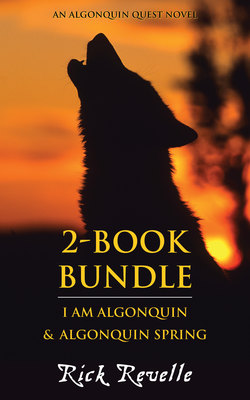Читать книгу Algonquin Quest 2-Book Bundle - Rick Revelle - Страница 15
На сайте Литреса книга снята с продажи.
10
ОглавлениеThe Amik
“WÀGOSH, AS WE WALKED from the ininàtig nòpimìng (maple forest) I noticed a pìtòshkob (pond). Let’s check to see if there is an amik-wìsh (beaver lodge) there. This is a good time of the year for amik pìwey (beaver fur).”
“Mahingan, I have rope for the arrows so that when we shoot them, they won’t swim away. It will be a nice treat to have some amikwànò (beaver tail) and beaver meat.”
We walked back along our trail beside a small river. The day was getting warmer, and I could feel the warmth of the sun on my face and also the heat radiating through my furs that I wore. Ishkodewan was doing a good job of keeping up with us. I had tied a rope around his neck to pull him along when necessary and then when he tired I would carry him for a distance. He still tried to nip at me, but whenever he did I gave him a slap on the nose. He soon got the meaning of this and quit.
After a short time we arrived at the pond. Our plan was to take no more than two beavers. That way we knew there would be more in the coming years. The Omàmiwinini never take more than is needed. That way we never incur the wrath of Kitchi Manitou.
We sat by the pond and ate some dry moose meat we had brought with us. We tied the rope to our arrows and to our waist. When a beaver is hit with an arrow it swims down into the water and heads for its watery home. With the rope tied around our waist, we stopped their progress and then pulled them to shore where we could finish them off with our clubs.
After sitting for a long time, two young beavers broke out of the water. We had made sure that we were downwind, and I had tied Ishkodewan in the forest. We let the beavers get close to our arrow range. Our bows twanged simultaneously. Wàgosh’s arrow hit his beaver on the animal’s side and mine was below the head. Our ropes tightened as the beavers dove back down into the water. It was then a race to see who pulled their kill to land first. The loser would have to carry the carcasses home. Wàgosh beat me handily. Mine was a fighter and when I got him to shore, he charged me. However, I was able to club him before he bit me.
Then, laying the beavers on their back on a large rock, we cut the legs off at the first joints and then slit the pelt starting at the lower lip. Inserting our knives into this slit we cut the pelt down the belly to the vent. Working from this centerline and cutting with short strokes, we separated the skin from the flesh. Carefully, we pulled the legs through the skin, leaving four round holes in the pelt. We then cut off the tail. With great care we cut around the eyes and the ears close to the skull. Then removing the pelt and being careful to take as little fat and flesh as possible we laid the pelt on the rock and wiped off the blood marks with water.
We then proceeded to take out the scent glands from near the tail and the insides of the legs, being careful not to rupture the sacs. We would use these scents to bait our snare traps for other beavers and for the odjìg (fisher), a predator of the beaver.
The beaver tails and meat would make a fine feast for us. Wàbananang would be able to stretch and clean the pelts and make a warm coat or hat.
After finishing with the beaver I wrapped the meat up into the skins and tied everything together and slung it over my shoulders to carry back. Wàgosh and I then went back and retrieved Ishkodewan from the woods and fed him a piece of the meat.
“Wàgosh, on the way back we’ll check the sap containers and dump what we have into our clay pots. Hopefully, we’ll have enough for the women to boil today.”
Upon reaching the maple forest we started to collect the sweet water. Then I heard an arrow whistle by my head and thud into the tree beside me.
